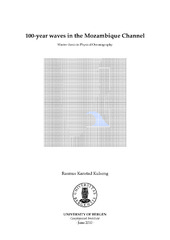100-year waves in the Mozambique Channel
Master thesis
Permanent lenke
https://hdl.handle.net/1956/7011Utgivelsesdato
2010-06-01Metadata
Vis full innførselSamlinger
- Geophysical Institute [1198]
Sammendrag
Six-hourly significant wave height (SWH) data covering the period September 1957 to August 2002 is obtained from the ERA-40 reanalysis. This data, generated by ECMWF's own configured global WAM model, stems from the first reanalysis in which a wave model is coupled to an atmospheric model. By accounting for the wave-atmosphere interaction this is the most comprehensive ocean state dataset available (Uppala et al., 2005). Based on this data, return values of SWH are estimated at five locations within the Mozambique Channel. In this work an extreme value is defined as the highest value of SWH which, on average, is only exceeded once during a period of 100 years, namely the 100-year return value. These extreme values are found by fitting both a Generalized Extreme Value (GEV) and Generalized Pareto (GP) distribution to SWH data, and thereafter, based on the behavior of the model, extrapolated to yield the 100-year return value. A thorough introduction to both extreme value models will be given. Furthermore, an introduction to goodness-of-fit tests which assess the validity of the model fits is given, followed by a routine which estimates the confidence interval (CI) for the return values. However, as the ERA-40 data does not account for bottom-wave interaction and, additionally, underestimates high wave values (Caires & Sterl, 2003a), the SWH data is refined by use of an altimeter-validated high resolution WAM model, covering the Mozambique Channel during 2001. Functional relationships are established between the five ERA-40 locations and the corresponding location of the self-run WAM model. By applying these on the ERA-40 data, the superior properties from the high resolution model, including bottom interaction, is extrapolated back to 1957. Along with return values, the temporal variability of SWHs within the Mozambique Channel is addressed. The results show return values up to 7.0 m with a 95% CI ranging from 6.6 to 7.5 m in the south, a value which decreases to 5.0 m in the northern opening of the Mozambique Channel. Based on monthly means, the extreme values are likely to occur during the winter months of June and July.
